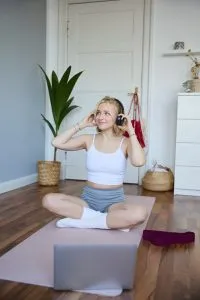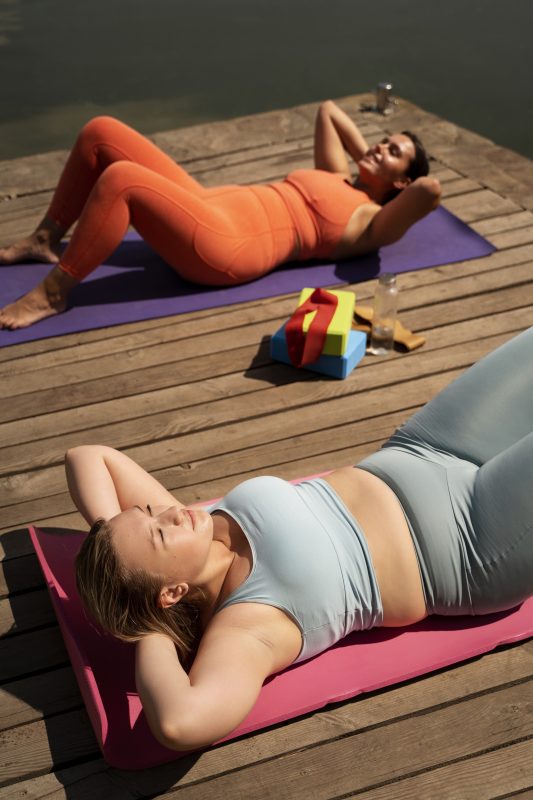
You might be surprised how many factors need to be decided on when you want to buy a yoga mat. It’s not as simple as going down to the local supermarket and choosing the nearest thing you can find.
The good thing is the more thought you give it now, the longer your mat will last and the better it will perform for exactly what you need it for.
Here’s the factors we recommend you need to think about before choosing a yoga mat:
- Thickness
- Portability
- Grippiness
- Material and Size
- Eco-friendliness
- Price range
- Which yoga style do you do?
- Caring for your yoga mat
How to Choose a Yoga Mat Thickness
The thickness of a yoga mat can affect your comfort and stability while doing your practice. For example, if you’ve got a thick mat and were doing a Mountain Pose you might topple over. So, you need to think carefully about which is more of a priority – comfort or stability or a bit of both.
Opt for a thicker mat if you have:
- Issues with your back,
- Bad knees,
- issues with your joints in general
- been practising yoga on a hard floor,
- prefer a restorative style of yoga.
The thicker mat will provide extra cushioning while you’re practising your yoga. That way you don’t end up with any aches or pains caused by feeling the floor through the mat.
You do need to be aware that a thicker mat can make it more difficult to do standing poses. Due to the thickness, it can make you feel a bit wobbly and unstable.
Opt for a thinner yoga mat if you have:
- practise a more vigorous style of yoga like hot, hatha or ashtanga
- need more stability or balance
- want a less bulky mat for storage
- like a mat that dries faster

How to Choose a Yoga Mat Weight
Hey guys! When picking your mat weight, it’s all about balancing portability with comfort.
If you’re always on the go, a lighter mat around 2-3 pounds is your best bet.
These thinner mats are super easy to carry, but keep in mind they might skimp a bit on cushioning.
If you’ve got sensitive joints, you might want to think twice before using these for long sessions.
Now, if you’re more of a homebody yogi or studio regular, and you’re craving that extra cushion, go for a heavier mat in the 5-7 pound range.
These bad boys offer better support and stability, which is awesome for those tricky balance poses or when you’re doing a lot of floor work.
Just remember, the heavier the mat, the more of a workout you’ll get just carrying it around!

How to Choose a Yoga Mat Grippiness
Let’s talk grip, because nobody wants to feel like they’re doing yoga on a slip ‘n slide, right?
Grippiness is non-negotiable, especially if you’re into those dynamic practices like Vinyasa or Ashtanga.
You want a mat that’s going to keep you grounded in your Downward Dog and Warrior II, no matter how sweaty things get.
Natural rubber mats are often the grip champions, providing excellent traction even in heated classes.
But if you’re a hot yoga enthusiast or tend to sweat buckets (no judgment here!), you might want to look into mats with a closed-cell surface or even a cork mat.
These materials are great at resisting moisture and preventing that dreaded slip-and-slide effect.
Remember though, what works for one yogi might not work for another, so don’t be afraid to test things out!
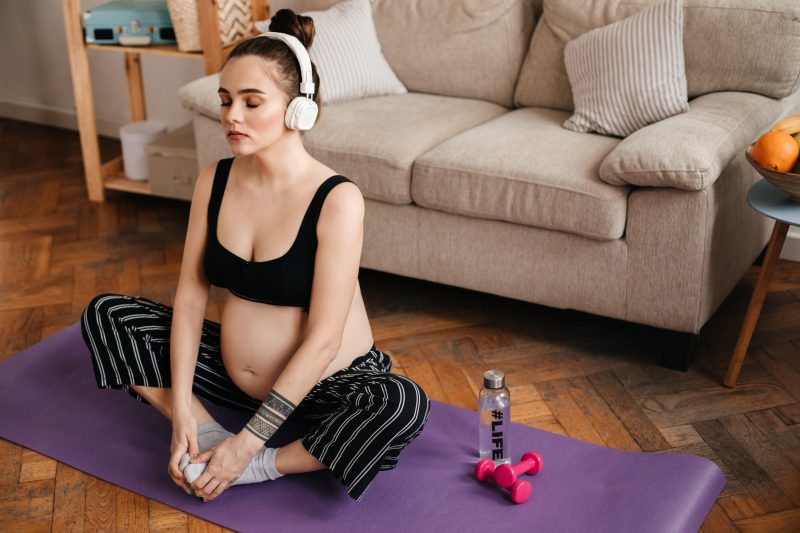
How to Choose a Yoga Mat Material and Size
Alright, let’s dive into materials and size – both super important for your overall yoga experience.
Common materials include natural rubber, PVC, and cork, each with their own perks.
Natural rubber is eco-friendly, biodegradable, and offers great grip, but heads up if you’ve got a latex allergy.
PVC mats are durable and often cheaper, but they’re not the greenest option.
Cork mats are awesome – sustainable, smooth, comfortable, and they’ve got natural antimicrobial properties (bye-bye, mat funk!).
Size-wise, most standard mats are about 68 inches long and 24 inches wide.
This works for most folks, but if you’re on the taller side or just like having extra space, don’t be shy about going for a longer or wider mat.
The right size lets you move freely without feeling cramped, so your practice can flow naturally.
How to Choose an Eco-Friendly Yoga Mat
For all you eco-conscious yogis out there, finding a truly green mat can be a bit of a maze with all the buzzwords and marketing.
Start by looking for mats made from natural or recycled materials like natural rubber, jute, or cork.
These are renewable, biodegradable, and often produced with minimal environmental impact.
But watch out for those “greenwashed” products – they talk the talk but don’t always walk the walk.
Certifications like OEKO-TEX or GOLS can be really helpful in verifying a mat’s eco-cred.
Also, think about durability – a long-lasting mat means less waste over time, making it a more sustainable choice in the long run.
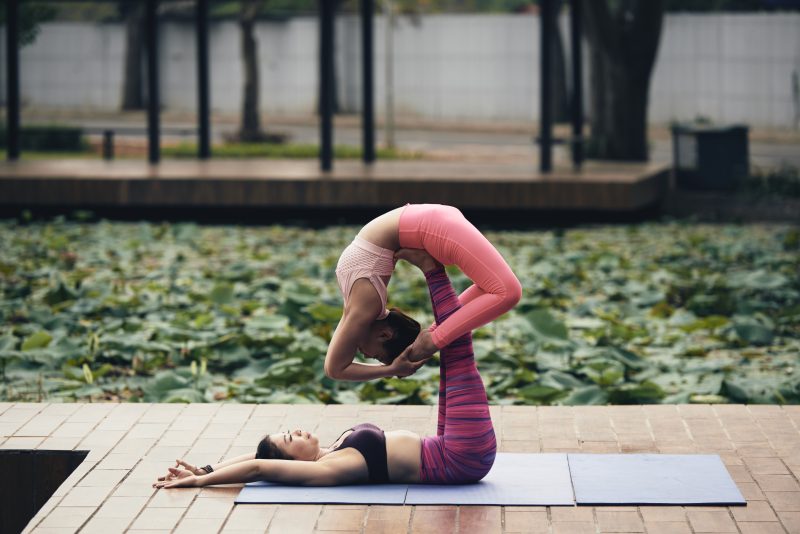
Yoga Mat Price Range
Let’s talk money, honey!
Yoga mats come in all price ranges, from budget-friendly options under $20 to fancy-schmancy mats over $100.
If you’re just dipping your toes into yoga or aren’t sure how committed you are yet, no need to break the bank.
A mid-range mat, around $50 to $70, often hits that sweet spot between quality and affordability, giving you decent durability and comfort.
For you dedicated yogis out there who practically live on your mats, investing in a premium mat might be worth it.
These pricier options often offer superior grip, support, and longevity, plus they might come with some extra eco-friendly brownie points.
Remember, your mat is an investment in your practice, so choose one that aligns with both your needs and your budget.
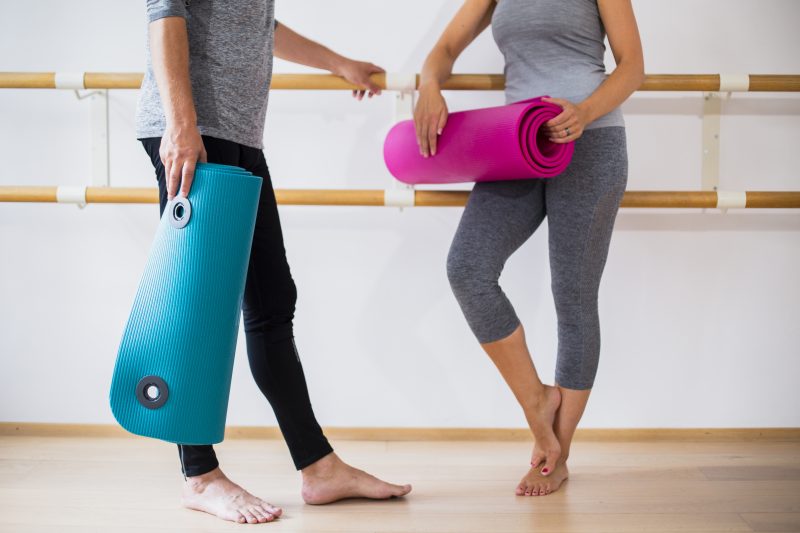
Which Yoga Style Do You Do?
Your yoga style should be a big factor in choosing your mat.
If you’re into the gentler stuff like restorative or Yin yoga, where you’re holding poses for what feels like forever, you’ll want a mat with extra cushioning to keep your joints happy and comfy.
For you Vinyasa or Power yoga enthusiasts, look for a mat with excellent grip and moderate thickness to help you flow smoothly between poses without any slipping mishaps.
Hot yoga warriors, you’ll want to seek out mats designed to handle sweat, with materials that offer good wet traction or even a mat-towel hybrid that you can toss in the wash easily.
If your practice is a mix of styles, aim for a versatile mat that offers a good balance of grip, cushioning, and durability to support you through all your yoga adventures.
Breaking in Your Yoga Mat
Breaking in your yoga mat is kind of like breaking in a new pair of shoes – it takes a little time, but it’s so worth it.
New mats, especially those made of natural rubber or PVC, can be a bit slippery at first or have a funky factory smell. Don’t worry, this is totally normal!
To speed up the break-in process, try unrolling your mat and letting it air out for a few days.
Some yogis swear by wiping it down with a mix of water and a few drops of mild soap, or using a cloth dampened with a vinegar-water solution to help remove any residue.
But honestly, the best way to make your mat feel like home is to use it regularly.
So, get on it, flow through your favorite poses, and before you know it, it’ll be as comfy as your favorite pair of yoga pants.
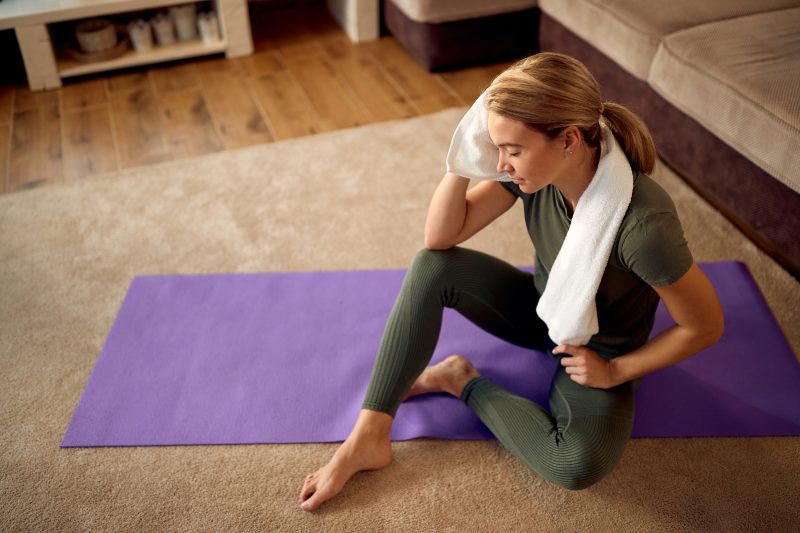
How to Care for Your Yoga Mat
Taking care of your yoga mat is key to keeping it in tip-top shape and hygienic.
After each sweaty session, give your mat a quick wipe down with a damp cloth or a mat cleaner.
For a deeper clean, use a gentle, natural cleanser – I like to use a mix of water and vinegar or mild soap.
Just steer clear of harsh chemicals that could mess up your mat or irritate your skin.
Always let your mat air dry completely before rolling it up – nobody likes a moldy mat!
This is extra important if you practice in a hot or humid environment.
Also, try to store your mat away from direct sunlight – too much sun can make the material break down faster.
With a little TLC, your mat will stay fresh and supportive through countless sun salutations and savasanas!
Who we are
At TopRatedYogaMats.com, we’re passionate about helping you find the perfect yoga mat to enhance your practice.
Our team of dedicated experts rigorously tests and reviews a wide range of yoga mats, providing unbiased, comprehensive information to guide your decision-making process.
We understand that the right mat can make a significant difference in your yoga journey, whether you’re a beginner or an experienced practitioner.
Our mission is to empower you with knowledge, offering detailed insights into comfort, durability, eco-friendliness, and overall performance of various yoga mats.
We collaborate with seasoned yoga professionals to ensure our content is not only factual but also practical and relevant.
While we may earn commissions through affiliate partnerships, our recommendations are always based on merit and genuine value.
At TopRatedYogaMats.com, we’re committed to fostering a supportive community where yoga enthusiasts can share experiences and find trusted information to support their wellness journey.
Meet our Instructors.




